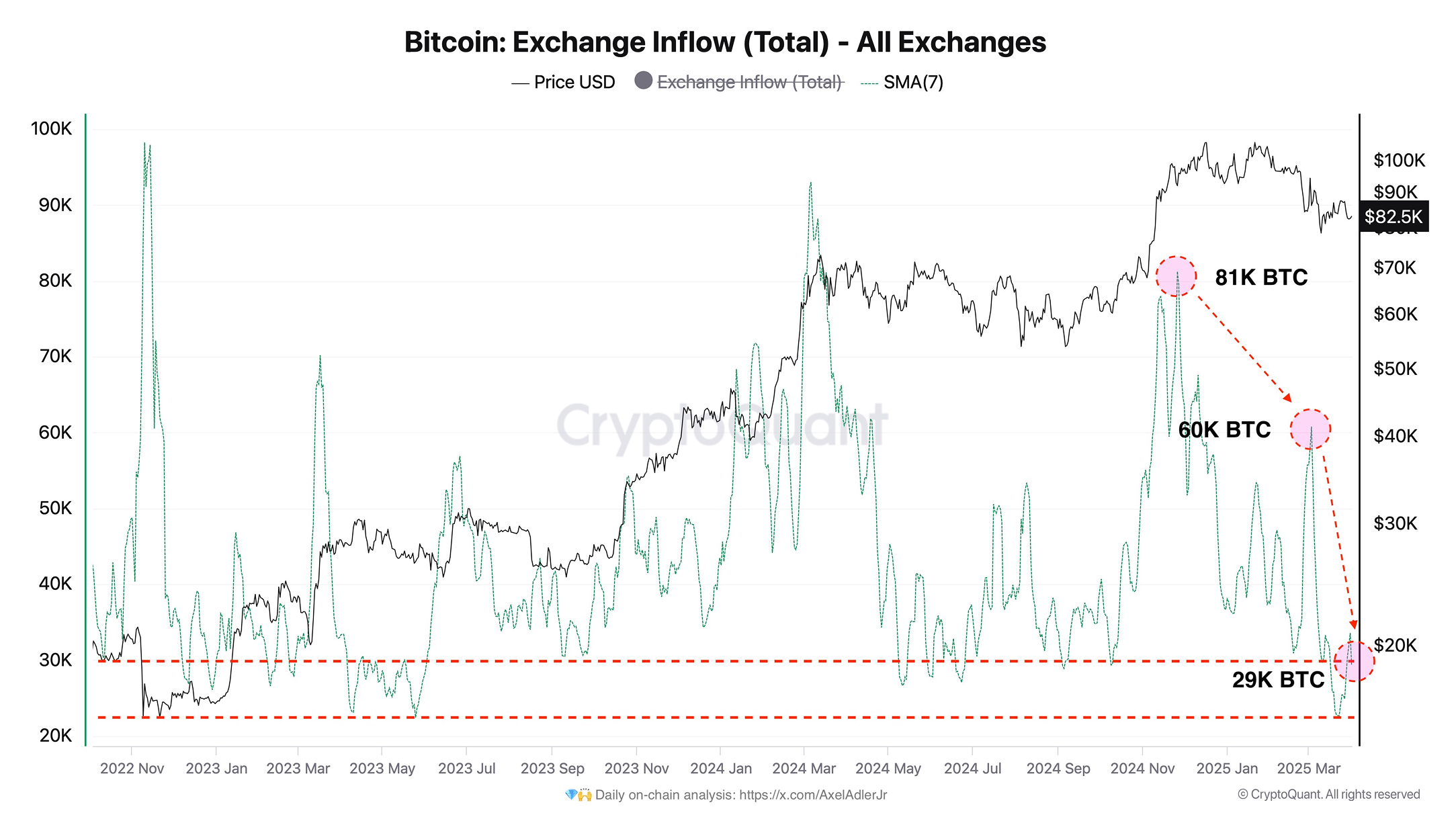This week, the crypto market is caught between optimism and uncertainty. After a strong rebound driven by central bank signals and whale accumulation, the focus now shifts to April 2—U.S. President Trump’s so-called “Liberation Day,” which could shake global markets in seconds with a fresh round of tariffs. Is this the calm before a breakout—or a warning before the storm? Let’s break it down.
Crypto Market Takes a Big Breath and Rises 3.8% in Last Hours – Busy Week Ahead

Bitcoin (BTC) started the previous week strong, boosted by dovish signals from the U.S. Federal Reserve and Donald Trump’s softer stance on trade tariffs. The Fed confirmed it would hold interest rates steady and projected two rate cuts in 2025, sparking optimism in both the crypto and stock markets. Bitcoin climbed past 82.000 € ($88,800) on March 25, setting a positive tone across the entire crypto sector.
However, by March 28, the market reversed course. Fear of an escalating trade war and renewed concerns about tariffs sent risk sentiment lower. Despite the turbulence, Bitcoin managed to hold above the 74.000 € ($80,000) support level. Analysts point out that the local bottom remains March 10, when BTC dropped to 65.600 € ($70,600)—a level now viewed as a potential correction floor.
As of today, Bitcoin is showing strength again, buoyed by positive signals and renewed investor confidence. The total crypto market cap rose by 3.8% in the last day, led by gains in BTC, ETH, and other large-cap assets. Still, this could be the calm before the storm, with a volatile week expected ahead, as April 2 marks Trump’s “liberation day”(read more below).
Massive Whales Are Back — And They Are Buying

Big players aren’t sitting on the sidelines. As Bitcoin’s price dipped to 76.000 € – 77.000 € ($81,000 $ – $82,000), whales began accumulating aggressively, echoing behavior from the early stages of previous bull markets.
Michael Saylor’s firm, now renamed Strategy, purchased over 22.000 BTC on Sunday, March 30—worth around 1,78 billion € ($1.92B)—bringing their total stash to over 528.000 BTC.
They weren’t the only ones. Last week, one whale added 186 million € ($200M) in BTC, while another—holding over 1,2 billion € ($1.3B)—reawakened after years of dormancy.
On-chain data confirms the trend. Whale wallets holding between 1.000–10.000 BTC are showing accumulation patterns remarkably similar to those seen during the 2020 bull cycle. Even during price corrections and broader market fear, these wallets are buying—not selling.
Exchanges Dry Up, Miners Stay Calm — Bullish Signs Stack Up

At the same time that whales are accumulating, exchange inflows have hit a two-year low, indicating fewer people are sending BTC to platforms to sell. The 7-day average inflow has dropped by 64% since November, a clear sign that selling pressure is drying up.
On the miner side (miners are people or companies that run powerful computers to validate Bitcoin transactions and earn BTC as payment), there’s no sign of panic either. The amount of BTC sent from miners to exchanges remains low, while Bitcoin’s mining hashrate—which measures the computing power securing the network—hit a new all-time high. Both are strong indicators of long-term confidence.
Looking forward, both institutional and on-chain signals remain optimistic. Analysts from Fidelity and CryptoQuant suggest that Bitcoin may be entering a new “acceleration phase”, where volatility and profit potential spike—similar to the breakout pattern seen in late 2020.
While BTC is still down about 25% from its all-time high, the current setup mirrors past cycles where major rallies followed shortly after.
All eyes now turn to April, as the coming weeks could reveal whether this is just a short-term bounce—or the true return of the bull. Some experts believe the market is underestimating how fast things could move:
“Bitcoin could hit new all-time highs before Q2 is out,”
said Jamie Coutts, chief crypto analyst at Real Vision, who believes we’ll see new record-high BTC prices before summer.
All Eyes on Trump’s “Liberation Day” as Tariff Storm Looms

This week’s volatility may just be the beginning. On April 2, U.S. President Donald Trump is expected to unveil new reciprocal trade tariffs, dubbing it “Liberation Day”—a symbolic moment that could redefine global trade policy and rattle markets.
So far, investors appear cautiously optimistic. Bitcoin bounced back above 78.000 € ($84,000) and the broader crypto market rallied, hoping for moderation in Trump’s stance. But many analysts warn this could simply be the calm before the storm.
Here’s what’s at stake:
- The U.S. has already announced 25% tariffs on auto imports and other goods from Mexico, Canada, and China, starting April 3.
- In response, Mexico and Canada signaled retaliation, raising fears of a full-blown trade war.
- The S&P 500 and Nasdaq are down, and crypto markets followed with a dip last week.
- Investor sentiment remains shaky as recession odds rise—with some economists now putting the probability at 40% for 2025.
At the same time, traders are bracing for key U.S. employment data also landing on April 2, which could further sway the Fed’s next move. QCP Capital summed it up:
“April 2nd will be the biggest escalation of the trade war to date. Markets are in for a wild week.”
In short, April may open with fireworks. With macro uncertainty, geopolitical tensions, and rate cut expectations all converging, the markets are on edge. Crypto is holding steady—for now—but investors should stay alert. This week could shape the next leg of the bull… or mark a temporary pause.
From institutional buying and miner stability to looming macroeconomic risks, this week offers both hope and caution. Whether we’re witnessing the start of the next leg up—or a pause before deeper volatility—one thing is clear: the next few days could be pivotal. Stay informed, stay prepared, and remember—strong hands build in uncertain times.





